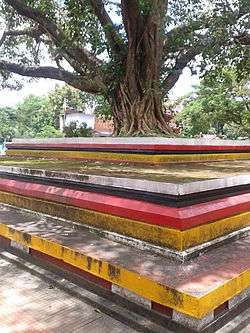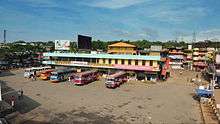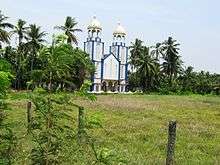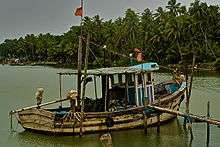Pazhayangadi
Pazhayangadi (Also called Payangadi), is a small township, approximately 22 kilometers north of district headquarters Kannur, 14 kilometers south of Payyanur and 14 kilometers west of Taliparamba in the South Indian state of Kerala. In the local language of Malayalam it literally means "Old Market". The town is bounded by the Madayi Hills (Madayippara) on the west and by the Pazhayangadi River on the south. Ezhimala, a range of hills, that is believed to be home to a variety of medical herbs including mrithasanjeevini, and a very ancient recorded history, is situated nearly 8 km west of Pazhayangadi. Pazhayangadi town is spread over Madayi and Ezhome Panchayaths. Madayi Hill offers a splendid scene of Ezhimala which means a chain of seven mountains, where the Indian Naval Academy is situated.
Pazhayangadi Payangadi | |
|---|---|
Town | |
 Madayi Kavu, Pazhayangadi | |
| Coordinates: 12°1′0″N 75°15′35″E | |
| Country | |
| State | Kerala |
| District | Kannur |
| Government | |
| • Type | Panchayath |
| • Body | Madayi Grama Panchayath, Ezhome Grama panchayath |
| Languages | |
| • Official | Malayalam |
| Time zone | UTC+5:30 (IST) |
| PIN | 670358,670303,670334 |
| Telephone code | 0497 |
| ISO 3166 code | IN-KL |
| Vehicle registration | KL-13 KL-59 |
| Nearest Towns | Kannur Payyanur Taliparamba |
| Lok Sabha constituency | Kasaragod |



History
From before the period of known history, some chapters of the Ramayana and local Hindu legends associate the Ezhimala Hills with the famous epic, in particular with Lord Hanuman.[1][2]
Ezhimala, Pazhayangadi, and several villages and towns in this region find plenty of mention in the extant Tamil Sangam Period's literature (500 BC to 300 AD). Pazhayangadi is the present corrupted form of its ancient name of Pazhi. Pazhi is mentioned as the ancient capital of King Udayan Venmon Nannan (known as Nannan or Nandan) of the Mushika or Kolathiri Royal Family. Though the Dynasty of Nannans was a cousin or sister dynasty of the Cheras and Pandyas and Cholas, warfare among them was nearly consistent, and the period of Nannan was no exception.[3][4][5][6] There are texts that speak of Nannan fighting heroic battles at Pazhi against the Chera Kings who invaded his kingdom (Kolathunadu). Eventually, Nannan was killed in battle by the Chera king, Narmudi Cheral. Like the other kings of the then Tamilakam cultural polity, Narmudi Cheral was a great patron of scholars and poets, and he once gifted his court-poet, Kappiyattu Kappiyanar with 40 lakhs gold coins, as a token of his poetic genius.
Extant Tamil Sangam texts describe the glory and wealth of the ancient Pazhi in the highest terms.[1] Sangam Era poets, as well as Classical Tamil poets of later centuries, like Paranar speak of the wealth of Pazhi in the greatest degree. One of the Sangam pieces, Akam 173 speaks of "Nannan's great mountain slopes where gold fields abound, and long bamboos dried in the Sun burst and released the unfinished pearls."[1] Noted scholar, Elamkulam Kunjan Pillai states that "It is from Kottayam (of North Malabar) and Cannanore regions of old Ezhimalainad that innumerable Roman (gold) coins have been excavated. On one (single) occasion (gold) coins that could be carried by six porters were obtained. These coins were found to belong to the period down to 491 AD".[1]
The Mooshaka Vamsam, written on the Mushika (Kolathiri) family of Nannan in the Eleventh Century, also mentions Pazhayangadi several times.
Ezhimala Hills
Pazhayangadi is just 8 kilometers away from Ezhimala which was the later Capital of the Kolathiri Dynasty. Pazhayangadi is famous for the Madayi Kavu which was a temple associated with the Kolathiris (Mushika Kings). The Madayi village which includes Pazhayangadi, is mentioned as Marahi in extant ancient texts, which was a famous port of the ancient times. Pazhayangadi has a lot of temples, such as the Vadakunda Shiva Templ at Madayi Para, and the Eripuram Sree Krishna Temple. The Tharapuram Sree Durgambika Temple is also a well-known temple at Pazhayangadi; and is well-known for its Kalampattu; the name Tharapuram itself derived from the name of the Goddess Thara (Uchulikadavathu Bagavathi). Sree Durga, along with Yakshiyamma is worshiped here. The recorded history of Pazhayangadi and nearby places which belonged to the Kolathunadu, is described in the book 'Kolathupuzha', written by MP Kumaran.
Economy
The local economy is based upon fisheries and agriculture. Majority of the locals are working in Persian Gulf countries and their remittances also contribute to the economy in a major way.
Environmental movements
Pazhayangadi is well known for environmental movements like Mangrove Conservation and Movement against Sand Mining. Noted environmentalist Kallen Pokkudan is from Pazhayangadi. A woman from Pazhayangadi called Jazeera appeared in a BBC report in 2013 [7] because of her lone fight against Sand Mining in Kerala.
Transportation
The national highway passes through Taliparamba town,≥payyannur pilathara area . Goa and Mumbai can be accessed on the northern side and Cochin and Thiruvananthapuram can be accessed on the southern side. The road to the east of Iritty connects to Mysore and Bangalore. The nearest railway station is Pazhayangadi on Mangalore-Palakkad line. Trains are available to almost all parts of India subject to advance booking over the internet. There are airports at Kannur, Mangalore and Calicut . All of them are international airports but direct flights are available only to Middle Eastern countries.
See also
References
| Wikimedia Commons has media related to Pazhayangadi. |
- Ramunny, Murkot (1 January 1993). Ezhimala: The Abode of the Naval Academy. Northern Book Centre. ISBN 9788172110529.
- Kareem, C. K. (1 January 1976). Kerala District Gazetteers: Palghat. Kerala, India: printed by the Superintendent of Govt. Presses.
- Indian History. Allied Publishers. ISBN 9788184245684.
- Devi, R. Leela (1 January 1986). History of Kerala. Vidyarthi Mithram Press & Book Depot.
- Proceedings of the Indian History Congress. Indian History Congress. 1981.
- Kalakam, Tañcai Tamilp Palkalaik (1 January 1994). Glimpses of Tamil civilization: articles from the university quarterly, Tamil civilization. Tamil University.
- Indian woman fights against sand mining in Kerala village – BBC News. Bbc.com. Retrieved on 2018-01-15.